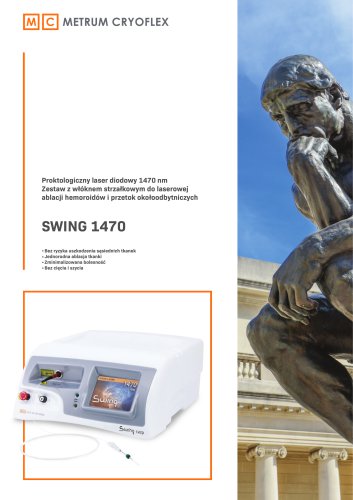 Website:
Metrum Cryofex
Website:
Metrum Cryofex
Catalog excerpts

Meet a new approach to acute postoperative chest wall pain treatment This is a medical device. Use it in accordance with the instructions for use or the label.
Open the catalog to page 1
Postoperative pain Post-thoracotomy pain (experienced by patients who have undergone surgery) is considered to be one of the most severe pain sensations. Intraoperative application of Cryoanalgesia prevents postoperative pain. The purpose of cryoanalgesia is to temporarily freeze and defrost a fragment of the intercostal nerve in its dorsal course. Active freezing and passive defrosting of the nerve is followed by blocking the transmission of pain impulses originating from the thoracotomy area. Even though the nerve regenerates quickly, it takes several months for the nerve impulses to be...
Open the catalog to page 2
During frosting and defrosting: - Significant endoneurial oedema when frosting and defrosting of the intercostal nerves. - Increased interstitial fluid pressure and Wallerian degeneration of the axon of intercostal nerve with the myelin sheath of the intercostal nerve remaining intact. After frosting and defrosting: - Schwann cell basal lamina remains intact facilitating the regeneration of the intercostal nerves. - When the endoneurium of the intercostal nerve remains intact, no neuroma is formed and the nerve is capable of regenerating at a rate of 1-1.5 mm/week. - The intercostal nerve...
Open the catalog to page 3
Electronic communication between the probe and the Built-in voice communication enables easier device control. device enables the device to identify the optimal operating A special system that reports essential data (procedure time, parameters and automatically configure them for the best device status) during the procedure allows full control cryoanalgesia performance. without taking your eyes off the treatment area. No manual adjustment of the freezing process is required during the preparation of the probe for treatment or throughout the procedure. When freezing is complete, the probe...
Open the catalog to page 4
CRYO - S ® Painless Cryoprobes Cryoprobe for thoracotomy and thoracoscopy intraoperative cryoanalgesia of the intercostal nerve. Advantages of the cryoprobe: The freezing tip is anatomically adjusted to the shape of the rib cage The freezing component of the probe is coated with gold to optimise freezing parameters. In addition, gold does not cause tissue allergy. intercostal nerve Cryoprobe for percutaneous cryoanalgesia of the intercostal nerve under ultrasoung guidance (USG). Advantage of the probe: Interpleural space Endothoracic fascia Freezes only with the tip Echogenic - clearly...
Open the catalog to page 5
Example of Cryoanalgesia procedure Freezing time: 120 seconds per nerve, Freezing target for thoracotomies: 2 intercostal nerves above thoracotomy, 2 intercostal nerves below thoracotomy and 1 intercostal nerve at thoracotomy level. Freezing area: recommended between the 4th and 9th intercostal space. The procedure can be performed unilaterally (thoracotomies, thoracoscopies). Freezing time 120 sec per intercostal nerve. Total time of cryoanalgesia during surgery: 12 min. Position of freezing tip of the probe: minimum 4 cm from the axis of the vertebral column; 2 cm from the sympathetic...
Open the catalog to page 6All Metrum Cryofex catalogs and technical brochures
-
Sleeksculpting
6 Pages
-
BOA series devices
8 Pages
-
Cryo-T Duo / 2
8 Pages
-
Cryo-S Mini for Dermatology
2 Pages



























